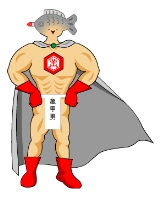
Soy Sauce Warrior Kikkoman
Encyclopedia

Superhero
A superhero is a type of stock character, possessing "extraordinary or superhuman powers", dedicated to protecting the public. Since the debut of the prototypical superhero Superman in 1938, stories of superheroes — ranging from brief episodic adventures to continuing years-long sagas —...
featured in a parody
Parody
A parody , in current usage, is an imitative work created to mock, comment on, or trivialise an original work, its subject, author, style, or some other target, by means of humorous, satiric or ironic imitation...
flash movie, based on the Kikkoman Japan
Japan
Japan is an island nation in East Asia. Located in the Pacific Ocean, it lies to the east of the Sea of Japan, China, North Korea, South Korea and Russia, stretching from the Sea of Okhotsk in the north to the East China Sea and Taiwan in the south...
ese soy sauce
Soy sauce
Soy sauce is a condiment produced by fermenting soybeans with Aspergillus oryzae or Aspergillus sojae molds, along with water and salt...
brand
Brand
The American Marketing Association defines a brand as a "Name, term, design, symbol, or any other feature that identifies one seller's good or service as distinct from those of other sellers."...
, that emerged in the early 2000s and became an Internet phenomenon.
The Kikkoman character was originally created in Shift-JIS
Shift-JIS
Shift JIS is a character encoding for the Japanese language originally developed by a Japanese company called ASCII Corporation in conjunction with Microsoft and standardized as JIS X 0208 Appendix 1...
by members of the large Japanese 2channel
2channel
is a Japanese textboard. In 2007 there were 2.5 million posts made every day. Launched in 1999, it has gained significant influence in Japanese society, comparable to that of traditional mass media such as television, radio, and magazines. As of 2008, the site generates revenue upwards of ¥100...
message board, but it was the flash movie created by Yogatori that made him famous worldwide. The movie has several references to Japanese food, anime
Anime
is the Japanese abbreviated pronunciation of "animation". The definition sometimes changes depending on the context. In English-speaking countries, the term most commonly refers to Japanese animated cartoons....
and tokusatsu
Tokusatsu
is a Japanese term that applies to any live-action film or television drama that usually features superheroes and makes considerable use of special effects ....
. To people who don't know much about these subjects and Japanese culture as a whole, the movie's tone can feel funny and unusual. It is also a good example of Engrish
Engrish
refers to unusual forms of English language usage by native speakers of some East Asian languages. The term itself relates to Japanese speakers' tendency to inadvertently substitute the English phonemes "R" and "L" for one another, because the Japanese language has one alveolar consonant in place...
, as seen on its translation to English
English language
English is a West Germanic language that arose in the Anglo-Saxon kingdoms of England and spread into what was to become south-east Scotland under the influence of the Anglian medieval kingdom of Northumbria...
("What a suckers!", for example). The chorus is also a pun that probably passes unnoticed to most non-Japanese speakers. "Show you" refers to "shōyu", the Japanese
Japanese language
is a language spoken by over 130 million people in Japan and in Japanese emigrant communities. It is a member of the Japonic language family, which has a number of proposed relationships with other languages, none of which has gained wide acceptance among historical linguists .Japanese is an...
word for soy sauce. This is also seen in the original version of the movie (the movie became famous well before an English translation was made available by the author).
There are two versions of the flash which have different variations of scenes, for example, in the scene where a cat is eating an omelet, the cat (Giko Cat) is embarrassed by stupidity and the variation, where the cat is either hanged by Kikkoman or the cat hangs himself after Kikkoman yells at him. Also, the scene where Kikkoman sleeps with the girl is noticeably different between the two versions. For example, in the version with Giko Cat hanging himself, the girl's upper half is not covered with a blanket, but with Kikkoman's arm covering it, and her left arm appears to be extended towards Kikkoman's crotch under the blanket. Obviously, in the other version, the blanket is draped over both of them. In that scene (in both versions) in the low left-hand corner, it jokingly says "Do Not Try This at Home, Kids." which also appears in the scene where Kikkoman hangs on to the bottom of a fish-shaped blimp in the sky.
The flash often circulates under the name "Kikkomaso". This is an intentional error in writing the name as it is rendered in Japanese katakana
Katakana
is a Japanese syllabary, one component of the Japanese writing system along with hiragana, kanji, and in some cases the Latin alphabet . The word katakana means "fragmentary kana", as the katakana scripts are derived from components of more complex kanji. Each kana represents one mora...
-- the character for 'n' (ン) is very similar to the character for 'so' (ソ), and, much like in many American internet communities, the intentionally-misspelled version came to be used for ironic effect.
External links
Official website for the Soy Sauce Warrior Kikkoman 2channel – The posting website where Kikkoman was born 2channel Mona BBS (Mona Ita or Mona Daisuki@2ch) – The 2channel Mona-BBS- Fight! Kikkoman (戦え!キッコーマン Tatakae! Kikkoman) – The Kikkoman flash movie
- Kikkoman - The other version of the Flash movie.
- Banana and Shrimp Showtime (怪人たちの歌 Kaijintachi no Uta) – A spinoff of the original movie by the same creator Soysauce Case #9(醤油入れ9 Shōyu Ire 9) in 2channel Mona BBS "( ・∀・)さん"'s Kikkoman parody (醤油入れ 過去ログ集 Shōyu Ire Kakorogu-Shu) from the 2ch.net Thread Log

